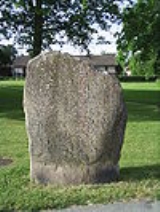
Kalleby Runestone
Encyclopedia
The Kalleby Runestone is an enigmatic Iron Age
runestone inscribed in Proto-Norse with the Elder Futhark
:
This short text has been the subject of several interpretations where þrawijan, which means "yearning", is interpreted as either a name or an epithet. The words haitinaz was mean "was named", and so the text is open to various interpretations, such as:
The stone is 2.1 metres (6.9 ft) tall and 1.6 metres (5.2 ft) wide, and it was formerly part of a bridge.
Iron Age
The Iron Age is the archaeological period generally occurring after the Bronze Age, marked by the prevalent use of iron. The early period of the age is characterized by the widespread use of iron or steel. The adoption of such material coincided with other changes in society, including differing...
runestone inscribed in Proto-Norse with the Elder Futhark
Elder Futhark
The Elder Futhark is the oldest form of the runic alphabet, used by Germanic tribes for Northwest Germanic and Migration period Germanic dialects of the 2nd to 8th centuries for inscriptions on artifacts such as jewellery, amulets, tools, weapons and runestones...
:
- þrawijan * haitinaz was
This short text has been the subject of several interpretations where þrawijan, which means "yearning", is interpreted as either a name or an epithet. The words haitinaz was mean "was named", and so the text is open to various interpretations, such as:
- Yearning was imposed (on him).
- Þrawija's (monument).
- (I/he) was commanded/called.
- (I/He) was promised to þrawija.
The stone is 2.1 metres (6.9 ft) tall and 1.6 metres (5.2 ft) wide, and it was formerly part of a bridge.
Sources
- RundataRundataThe Scandinavian Runic-text Data Base is a project involving the creation and maintenance of a database of runic inscriptions. The project's goal is to comprehensively catalog runestones in a machine-readable way for future research...
- The runestone on the site of the Swedish National Heritage Board.

